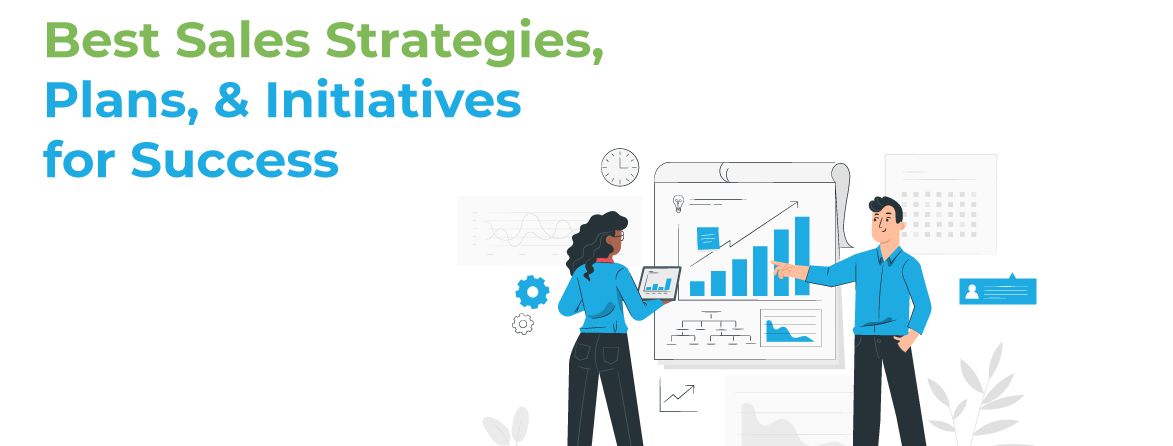What is a Sales Plan?
A sales plan is much like a traditional business plan, but focuses specifically on a sales strategy. It lays out your goals, objectives, target audience and potential obstacles. While a business plan lays out your goals, a sales plan is what makes them happen.
An effective plan should do the following:
- Communicate your company’s goals to your sales team
- Provide a strategic idea for your sales team
- Include roles and responsibilities for the team, as well as leadership
- Monitor the sales progress
A methodical plan is going to bring in more customers and more revenue, but one that isn’t so tactical can cause a negative impact on the market, and even act as a demotivating factor for internal stakeholders. That’s why it’s important to have a good sales strategy plan.
Types of Sales Strategy
Depending on the industry, sales strategies differ. Here is a list of strategies that fit most industries:
- Know the Product
Obvious right? You’d think. But many salespeople don’t actually know, or want to know in depth about the product they’re selling. And if they don’t know a product, how is the customer going to get to know it? That’s why it’s crucial to know everything about the product, so a salesperson can best answer any question or concerns that come their way.
- Translate the Features into Benefits
The customer must be able to understand the product, and for that to happen, a salesperson must understand the benefits of the product TO the customer. Every product has features, so it’s very important for the customer to understand the benefits of those features. Think about a computer having an i7 processor. A customer may not know the benefit of that feature, so it’s up to the salesperson to explain that an i7 processor means a faster computer.
- Bring the New, but Maintain the Existing
In order for a business to grow, news customers have to show up. But remember… you wouldn’t have a business if it weren’t for the customers you already have. New customers or new products can maximize revenue for the company, but it’s equally as important to maintain your current customers in order to get repeat business.
- Listen
Communication is by far the most important sales strategy. It’s what brings salespeople to customers and vice versa. The conversation should always be give and take, and a consistent ebb and flow of useful information or solutions. Always listen to what a customer is trying to tell you, wholeheartedly. It’s also important to repeat what the customer said back to them, to avoid confusion.
- Follow Up
As a salesperson, it is crucial to always follow up with a potential or existing customer. It may take a few tries due to conditions on the other side, but persist, and don’t be scared to ask the customer for a date and time when it’s best to call them. Constant and regular follow-ups is good customer service and also creates trust in the customer.
Building a Sales Strategy Plan
The following are all things you need to include in your sales strategy plan.
- Mission and Background: State your company’s mission, vision and history.
- Team: Describe who’s on your team and their roles
- Target Market: What’s your target demographic? Who are your best customers? Do they struggle with a challenge?
- Tools, Software, and Resources: A description of your resources. What software do you use? What’s your budget for sales contests or incentives? What tools do your salespeople use to succeed at their jobs?
- Positioning: Name your competitors, their pricing vs. yours, and how your product compares.
- Marketing Strategy: Describe your pricing and any promotions you have. How will you generate leads and brand awareness?
- Prospecting Strategy: How will your team qualify the leads given to them from the marketing strategy? Identify inbound and outbound sales methods.
- Action Plan: This section summarizes your game plan for hitting all your revenue targets. Example: A. Objective: Increase referral rates by 30% this quarter
- Run three-day referral techniques workshop
- Hold sales contest for referral sales
- Increase commission on referral sales by 5%
- Goals: Most sales goals are revenue based. Set a volume goal or a total target.
- Budget: Describe the costs associated with hitting your sales target goals.
Inbound vs. Outbound Sales
The main difference between inbound and outbound sales is who initiates the sale. With inbound, the customer, or prospect, will initiate the process because they already know about the product and show interest in it. With outbound, it’s the salesperson who contacts the prospect first, in hopes that they will become interested in the product.
Conclusion
To take initiative is to go out and do something without being told to. The same is with sales initiative. Being proactive generates more leads, customers and sales. Sales is by no means easy, but it is a highly useful and crucial aspect of any business. Don’t be afraid to take initiative. By now, you should have your own sales strategy plan, which will also help you in your endeavors. The rest is up to you.
About Target River
Target River is a target marketing firm, backed by global buying power to deliver cost-efficient campaigns that deliver results. Our team utilizes on point targeting with pinpoint accuracy. We exist to delight our clients with campaigns that effectively target the right audience, reach that audience through the most cost-efficient tactics, and deliver the most relevant message.
Target River was recently recognized as “Marketing Agency of the Year”, “Best Target Marketing Company”, and “Best Education Marketing Company” in the United States. For further information, please contact brian@targetriver.com or call 619.330.0153. www.targetriver.com.

